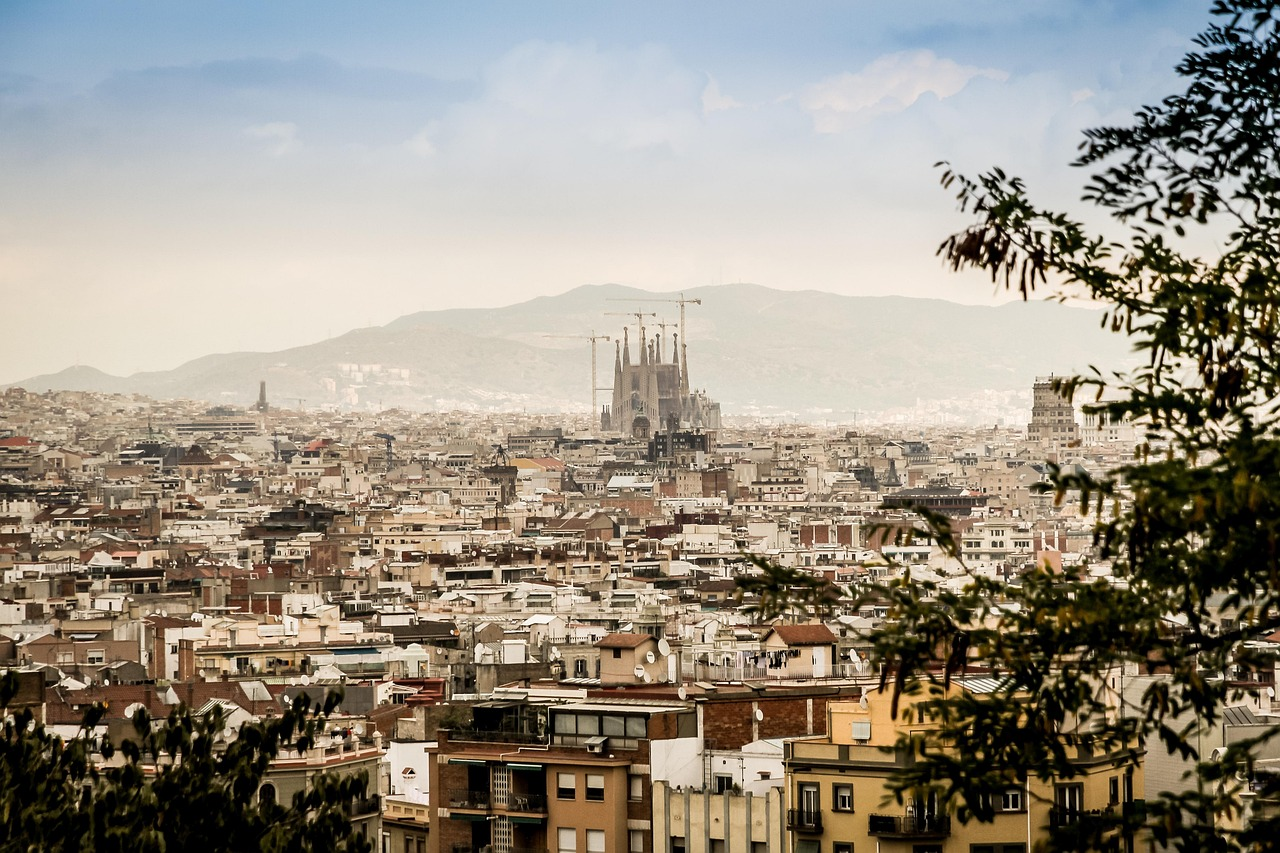
23 May 10 Best Things to Do in Barcelona
Barcelona, capital of Catalonia and Spain’s second biggest city, is a beautiful and vibrant city. Discover its delicious gastronomy, dance to the rhythm of its nightlife, stroll through the well-preserved Barrio Góctic, spend a day at the beach and marvel at its original architecture. You can do all this and much more when you visit Barcelona. That’s why Málda Singular Hotel has prepared a list of its 10 must-do in Barcelona.
-
Marvel at the Sagrada Familia
It is impossible to visit Barcelona without planning a visit to the Sagrada Familia, the city’s most emblematic building.
Fusing Gothic and Art Nouveau styles in an unprecedented way and also drawing inspiration from nature, the Sagrada Familia, designed by the influential artist Antoni Gaudi, began in 1882 and is still unfinished. In fact, the numerous plans left behind by the brilliant architect have enabled his successors to undertake the rest of the work.
Its striking beauty, its symbolism, its abundant light, the explosion of colors emanating from its stained-glass windows and its highly educational museum are just some of the reasons why the Sagrada Familia is a must-see when visiting Barcelona.

The Sagrada Familia and the skyline of Barcelona
Fun fact: The work had been considered illegal for all these years, and it wasn’t until 2018 that the Sagrada Familia finally got its building permit. The monument is due to be finished in 2026 or 2027 and will reach a height of 172m, making it the tallest building in Barcelona.
The Sagrada Familia is located in the neighborhood of the same name, in the heart of Barcelona. To get to the Sagrada Familia from the hotel you can take the metro or a taxi (approx. 20 min). How to get there
To save time and make the most of your visit to Barcelona, we recommend you to buy your tickets in advance.
-
Admire the views from Park Güell
We continue with Gaudí’s works of art: Park Güell is another of Barcelona’s must-see tourist attractions, declared a World Heritage Site.
Park Güell is one of those places you have to see to believe it. It is 20 hectares of public gardens and original architecture, designed by commission of Eusebi Güel and built between 1910 and 1914, although it was not opened as a public park until 1926. It originally consisted of 60 luxury houses on the most beautiful plot of land in the city, far from the chimneys of the centre. Only 4 houses were built for budgetary reasons.
Today there are several things that should convince you to include Park Güell in your “Barcelona bucket list“. Firstly, for the beautiful views, as Park Güell is situated on a hill overlooking the city. Secondly, for the buildings and monuments designed by Gaudí. Thirdly, for the gardens themselves, a wonderful place to stroll around.
In summer, the park seems to come alive, with musicians playing. In winter, the atmosphere is more sober, but you can enjoy a pleasant change of pace from the hustle and bustle of the city streets.

© Pixbay
To get to Park Güel from the hotel you can take the metro or a cab (approx. 20 min). How to get there
Entrance to the park is free, but some of the park’s attractions are not. To save time and make the most of your visit to Barcelona, we recommend you to buy your tickets (link to buy tickets) in advance.
-
Strolling along the Passeig de Gràcia
It is the main artery of the modern city: the “Champs-Élysées” of Barcelona.
Originally, Passeig de Gràcia was the avenue where the rich families of Barcelona lived. It is home to some magnificent villas, some of them obviously designed by Gaudí (Casa Batlló and Casa Milà), but also by Puig y Cadafalch, another well-known Barcelona architect (Casa Amatller).
Passeig de Gràcia is also the ideal place to go shopping in the countless luxury stores that line the promenade, such as Chanel, Yves-Saint-Laurent, Cartier, Hermès, Gucci…

Panoramic view of Passeig de Gràcia in Barcelona
To get to Passeig de Gràcia from the hotel you can walk (approx. 10 min). How to get there
La Casa Milà
Casa Milà, along with other works of art by Antonio Gaudí, is one of 48 World Heritage Sites in Spain. Also known as “La Pedrera” for its elaborate stonework, La Casa Milà was built between 1906 and 1912 and was Gaudí’s last civilian project before his death and represents the pinnacle of his career.
This unconventional apartment building by Antoni Gaudí, built for the city’s wealthiest industrialists, lacks straight lines and is wobblier than the building itself. Seen from above, it is actually built in the shape of an asymmetrical figure eight. It is also perhaps the most spectacular rooftop you have ever seen, with its 28 chimneys.
It hosts cultural activities of all kinds, so we recommend you to buy tickets and check their agenda before visiting Barcelona to know their programming.

La Pedrera by Antoni Gaudí. Photography by Glob@l Comunicación; Helena Encinas and Pepe Encinas
La Casa Batlló
Casa Batlló is another emblematic building in Barcelona, designed by Gaudí and declared a World Heritage Site by UNESCO. Located on Barcelona’s Passeig de Gràcia and built between 1904 and 1906, it is considered one of the most important Art Nouveau buildings in Barcelona and is considered one of the jewels of modern architecture in the city.
The undulating facade, with its mosaics, wrought iron balustrades and eggshell windows, is world famous and has earned it the nickname “House of Bones“. Inside it is equally impressive with the legendary noble floor (the former residence of the Batlló family), the attic (the former sheds and laundry rooms), the terrace and the mythical chimneys (where the spine of the dragon killed by St. George is found), as well as the magnificent inner courtyard (the former stairwell).
From March, blues, rock, soul, jazz, swing, pop and flamenco shows under the Barcelona night sky take place in what is undoubtedly one of the most intimate and aesthetically pleasing places to listen to music from around the world. Tickets include a tour of the house and a drink. See magic-nights.
To save time and make the most of your visit to Barcelona, we recommend that you buy your tickets in advance.

© Pixbay
The two houses are located less than 500m from each other on Passeig de Gràcia.
-
Getting lost in Ciutat Vella
The Ciutat Vella is located in the heart of the old town of Barcelona, the first district of the city, where you can admire the remains of Roman ruins and medieval architecture. Strolling through its streets and squares is an invitation to discover the history of Barcelona’s old town.
Among its cobblestone streets, behind its historic walls, next to small and large churches, you will find a lot of little corners with which to end up falling in love with Barcelona. Places like the famous Rambla, the Cathedral of Barcelona, or museums as emblematic as the Picasso Museum.
And in the extensive area of the Ciutat Vella are some of the most emblematic neighborhoods of Barcelona as the Raval, the Gothic, the Born or Barceloneta. We advise you to visit these essential tourist spots that are distributed in them, take note:



La Rambla /Mercado de la Boquería /Rambla del Raval



Catedral de Barcelona/El Pont del Bisbe/Palau de la Música Catalana



Basílica de Santa María del Mar/Iglesia de Santa María del Pi/Playa de la Barceloneta
The hotel is located in the old town of Barcelona, in the Barrio Gótic, you don’t have to go far to travel back in time.
-
Visit the Museu d’Història de la Ciutat (City History Museum)
The history of Catalonia is revealed in the Museu d’Història de la Ciutat.
Located in the Barrio Gòtic of the Ciutat Vella, in the Plaça del Rei, the main museum is accessed through the inner courtyard of the Casa Padellas, which is the finest example of a Catalan Gothic inner courtyard. Often known by its acronym, MUHBA, the Museu d’Història de la Ciutat de Barcelona is one of the two museums you should include on your list of top visits in Barcelona.
The Catalan region has a long history and a unique identity that distinguishes it from the rest of Spain. We have chosen to introduce you to this one because the museum will transport you back 2 millennia, when the Romans built a city here called Barcino. Among the highlights of the museum are the excavated remains of the largest
Roman settlement ever discovered in Europe. You will discover ancient rooms and ceramics from Roman times.

MUHBA – Museo de Historia de Barcelona.
To get to the Museu d’Història de la Ciutat from the hotel you can walk (approx. 5 min). How to get there
- Take a look at the Picasso Museum
One of the most influential artists of the 20th century, Pablo Picasso was born in 1881 in Malaga and spent part of his youth here in Barcelona. The Picasso Museum was founded in 1963, becoming the first museum in the world dedicated to the artist and presenting one of the largest collections of Picasso’s works of art. Organized chronologically, the museum has more than 4,200 works of art and includes objects created when the artist was just a child.
Specifically, in the rooms of this museum you can see the complete collection of 57 works of art from the “Las Meninas” series, the only series by the master in which all the works of art are gathered in one place. The two main works of art exhibited here are two of Picasso’s first major compositions: First Communion and Charity, painted in 1896 and 1897 respectively.



Picasso museum courtyard / Pablo Picasso / © Juan Ávila -Museo Picasso
To save time and make the most of your visit to Barcelona, we recommend that you buy your tickets in advance.
-
Pretending to be Messi at Camp Nou
What to visit in Barcelona if you like sports and in particular soccer?
A must for soccer fans is a visit to Camp Nou, the stadium where the mythical Futbol Club Barcelona plays, one of the most successful and famous clubs in the world. FC Barcelona is a legendary soccer club, but it is also the soul of the city. The blaugrana club, as it is known here, has the motto “more than a club”, and not without reason. In addition to soccer, Camp Nou‘s fame is partly due to the important role it played under the fascist dictatorship of General Franco in the mid-20th century. The soccer stadium was one of the only places where Barcelonians could speak the banned Catalan language.
Although nothing compares to attending a match at the Camp Nou, it is possible to savor the “Barça” experience in the combined tour “Camp Nou Experience” allows you to visit the Barça stadium, the largest in Spain and Europe, as well as the FC Barcelona Museum. A total immersion in the world of Spanish soccer is guaranteed. But, if your visit coincides with a Barça match you can buy tickets from their official website

Camp Nou in a La Liga match – F. C. Barcelona
To get to Camp Nou from the hotel you can take the metro or a cab (approx. 20 min). How to get there
-
Admiring the sunset from Tibidabo (and Carmel Bunkers)
The sunsets in Barcelona also have a special place in this list. In this case, to see a fantastic sunset with the best views of Barcelona, you should not miss the Tibidabo Hill.
Tibidabo is a 512m high mountain that dominates the city of Barcelona. This fact makes it a special place to go to enjoy extraordinary views of the city and, beyond that, the Mediterranean. In fact, no other place in Barcelona offers such magnificent views. Also the thing to do on Tibidabo is to visit the remarkable Sagrat Cor Church (Parisian Sacré-Cœur style), a minor basilica that can be seen from every corner of the city and stands proudly on top of Tibidabo mountain. It was built between 1902 and 1961 in neo-Gothic style and has a beautiful interior, which must be seen once at the top. In addition, this Barcelona attraction is the amusement park. This historic attraction has been in operation since 1899 and still has many of the original rides and attractions.

The Tibidabo Roller Coaster | Tibidabo
There is another place closer to the center of Barcelona and accessible on foot from where to have a bird’s eye view of the city. It is the Bunkers of Carmel, an anti-aircraft battery that played an important role in the defense of the city during the Spanish Civil War. Today not much remains of it, except for a magnificent 360° view of the entire city of Barcelona.

Carmel Bunkers
To get to Tibidabo or the Carmel Bunkers from the hotel you can take the metro or a cab (approx. 30 min). How to get there
-
Walking the hill of Montjuïc
If you visit Barcelona, the hill of Montjuïc is the perfect place for a green walk with magnificent views of the city and the sea. Undoubtedly the most famous hill in Barcelona, it has become an important cultural center. Montjuïc really took off with the Universal Exposition of 1929 (construction of numerous palaces and other sports facilities, in addition to the Poble Espanyol). Since then, numerous cultural infrastructures have been added to the existing heritage: Archaeological Museum, Ethnological Museum, Joan Miró Foundation, Fran Daurel Foundation, CaixaForum Foundation….
The best (and most original) way to get to Montjuïc is to take the cable car from the port. This cable car has preserved its original style: it will allow you to reach the port of the city or Barceloneta while enjoying an original view of Barcelona. At the top of the hill, you will find a 17th century fortress, which was the scene of the Catalan revolt in the 1600s, and which also witnessed battles during the Civil War in the late 1930s before becoming a prison.

© Pixbay
After the visit you can take a walk through the sports facilities built during the 1992 Olympic Games such as the Olympic Stadium Lluís Companys, the Palau Sant Jordi, the Bernat Picornell Swimming Pools and the Calatrava Tower, to finish in front of the National Art Museum of Catalonia (MNAC), one of the best museums in Barcelona that has two free terraces with excellent views.
At night, don’t miss the Magic Fountains of Montjuic: an amazing light and sound show of musical fountains. A must-see at least once, especially with children!

The “Font Magica” (“magic fountain”) in front of the Palau Nacional
Para llegar a la colina de Montjuïc desde el hotel pueden tomar el metro o un taxi (aprox. 10 min). Cómo llegar.
-
Passeig de Sant Joan, Arc de Triomphe and Parc de la Ciutadella: a 3 in 1
The Passeig de Sant Joan connects the Barrio de Gràcia with the Arc de Triomf, that is, the Barrio del Born. But Passeig de Sant Joan not only connects two of the city’s coolest neighborhoods, it has also become a trendy place for locals to stroll or cycle, the epicenter of interesting bars and restaurants, charming stores and surprising establishments. The history of the Passeig dates back to the end of the 19th century, when the construction of the Eixample began. Its name is a tribute to the old passeig that surrounded the Ciutadella esplanade and disappeared when the old fortress was demolished.
Barcelona’s Arc de Triomf, at the end of Passeig de Sant Joan, is not of a military nature like others around the world. It was built as the main entrance to the Universal Exposition of Barcelona in 1888. This event filled iconic monuments in cities like Paris, the Eiffel Tower or Brussels, the Atomium. The most curious thing about the monument is that its architect, Josep Vilaseca, decided to use a neo-Mudejar style and build it with brick and white stone friezes. The sculptures refer to science, art, agriculture and trade.

© Pixbay
And finally it leads to the Ciutadella Park, one of the green lungs of the city and yes, you guessed it: it is another place to visit in Barcelona without fail. Ciutadella Park was also built for the Universal Exposition of 1888, on the site of a fortress that had previously been used as a prison during the Napoleonic era. This beautiful green space is home to an impressive waterfall, centuries-old trees, museums, a lake where you can take a boat ride and / or the Barcelona Zoo.

© Pixbay
For us these would be the main things to do in Barcelona that we would recommend to anyone who asks us, of course there are many more because it is a city that gives a lot!
Would you add any essential things to do in Barcelona? We look forward to hearing from you in the comments.
 655 789 186
655 789 186


No Comments